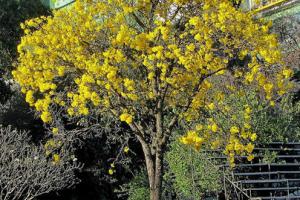Risk Tool
Ipe Tabebuia serratifolia
Also know as: Yellow poui, groenhart, arewood, bastard lignum-vitae, bethabara, greenheart, May-flower, noib wood, trumpet flower tree, ipe, ipe tobaco, pau d’Arco, bethabara

T. serratifolia, commonly known as yellow poui or ipe, is a large deciduous tree native to evergreen lowland forests in tropical Central and South America. The tree can grow up to 37m in height and 3m in trunk diameter. During the dry season, the leaves fall off and are replaced with yellow flowers that remain until the rainy season sets in.
Like other Tabebuia species, the yellow poui is used for medicinal purposes. The olive-brown wood is highly resistant to decay and is strong, dense and durable. Timber is used for bridges, house posts, decking, construction, turning, factoring flooring, tool handles, cabinet work, and veneer. This species has not been evaluated by the IUCN Red List.
Species Details
Tabebuia serratifolia is not listed on any appendix of the Convention on International Trade of Endangered Species of Wild Fauna and Flora (CITES). It has not been evaluated for inclusion on the IUCN Red List.
Countries Where Found
Sources
National Tropical Botanical Garden – Meet the Plants: “Tabebuia serratifolia”